Jiacheng Ye
Implicit Search via Discrete Diffusion: A Study on Chess
Feb 27, 2025Abstract:In the post-AlphaGo era, there has been a renewed interest in search techniques such as Monte Carlo Tree Search (MCTS), particularly in their application to Large Language Models (LLMs). This renewed attention is driven by the recognition that current next-token prediction models often lack the ability for long-term planning. Is it possible to instill search-like abilities within the models to enhance their planning abilities without relying on explicit search? We propose DiffuSearch , a model that does \textit{implicit search} by looking into the future world via discrete diffusion modeling. We instantiate DiffuSearch on a classical board game, Chess, where explicit search is known to be essential. Through extensive controlled experiments, we show DiffuSearch outperforms both the searchless and explicit search-enhanced policies. Specifically, DiffuSearch outperforms the one-step policy by 19.2% and the MCTS-enhanced policy by 14% on action accuracy. Furthermore, DiffuSearch demonstrates a notable 30% enhancement in puzzle-solving abilities compared to explicit search-based policies, along with a significant 540 Elo increase in game-playing strength assessment. These results indicate that implicit search via discrete diffusion is a viable alternative to explicit search over a one-step policy. All codes are publicly available at \href{https://github.com/HKUNLP/DiffuSearch}{https://github.com/HKUNLP/DiffuSearch}.
Scaling Diffusion Language Models via Adaptation from Autoregressive Models
Oct 23, 2024
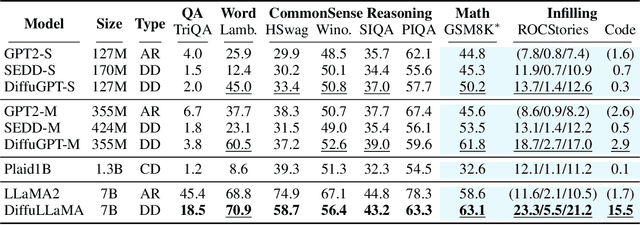
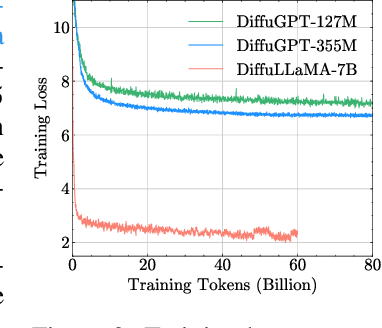
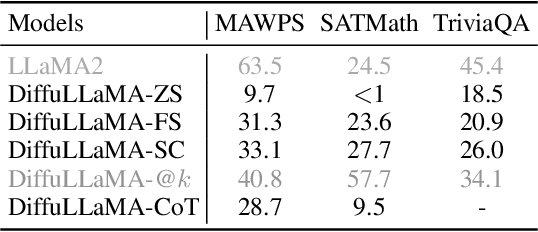
Abstract:Diffusion Language Models (DLMs) have emerged as a promising new paradigm for text generative modeling, potentially addressing limitations of autoregressive (AR) models. However, current DLMs have been studied at a smaller scale compared to their AR counterparts and lack fair comparison on language modeling benchmarks. Additionally, training diffusion models from scratch at scale remains challenging. Given the prevalence of open-source AR language models, we propose adapting these models to build text diffusion models. We demonstrate connections between AR and diffusion modeling objectives and introduce a simple continual pre-training approach for training diffusion models. Through systematic evaluation on language modeling, reasoning, and commonsense benchmarks, we show that we can convert AR models ranging from 127M to 7B parameters (GPT2 and LLaMA) into diffusion models DiffuGPT and DiffuLLaMA, using less than 200B tokens for training. Our experimental results reveal that these models outperform earlier DLMs and are competitive with their AR counterparts. We release a suite of DLMs (with 127M, 355M, and 7B parameters) capable of generating fluent text, performing in-context learning, filling in the middle without prompt re-ordering, and following instructions \url{https://github.com/HKUNLP/DiffuLLaMA}.
Beyond Autoregression: Discrete Diffusion for Complex Reasoning and Planning
Oct 18, 2024



Abstract:Autoregressive language models, despite their impressive capabilities, struggle with complex reasoning and long-term planning tasks. We introduce discrete diffusion models as a novel solution to these challenges. Through the lens of subgoal imbalance, we demonstrate how diffusion models effectively learn difficult subgoals that elude autoregressive approaches. We propose Multi-granularity Diffusion Modeling (MDM), which prioritizes subgoals based on difficulty during learning. On complex tasks like Countdown, Sudoku, and Boolean Satisfiability Problems, MDM significantly outperforms autoregressive models without using search techniques. For instance, MDM achieves 91.5\% and 100\% accuracy on Countdown and Sudoku, respectively, compared to 45.8\% and 20.7\% for autoregressive models. Our work highlights the potential of diffusion-based approaches in advancing AI capabilities for sophisticated language understanding and problem-solving tasks.
PRoLoRA: Partial Rotation Empowers More Parameter-Efficient LoRA
Feb 24, 2024



Abstract:With the rapid scaling of large language models (LLMs), serving numerous LoRAs concurrently has become increasingly impractical, leading to unaffordable costs and necessitating more parameter-efficient finetuning methods. In this work, we introduce Partially Rotation-enhanced Low-Rank Adaptation (PRoLoRA), an intra-layer sharing mechanism comprising four essential components: broadcast reduction, rotation enhancement, partially-sharing refinement, and rectified initialization strategy. As a superset of LoRA, PRoLoRA pertains its advantages, and effectively circumvent the drawbacks of peer parameter-sharing methods with superior model capacity, practical feasibility, and broad applicability. Empirical experiments demonstrate the remarkably higher parameter efficiency of PRoLoRA in both specific parameter budget and performance target scenarios, and its scalability to larger LLMs. Notably, with one time less trainable parameters, PRoLoRA still outperforms LoRA on multiple instruction tuning datasets. Subsequently, an ablation study is conducted to validate the necessity of individual components and highlight the superiority of PRoLoRA over three potential variants. Hopefully, the conspicuously higher parameter efficiency can establish PRoLoRA as a resource-friendly alternative to LoRA.
Diffusion of Thoughts: Chain-of-Thought Reasoning in Diffusion Language Models
Feb 12, 2024
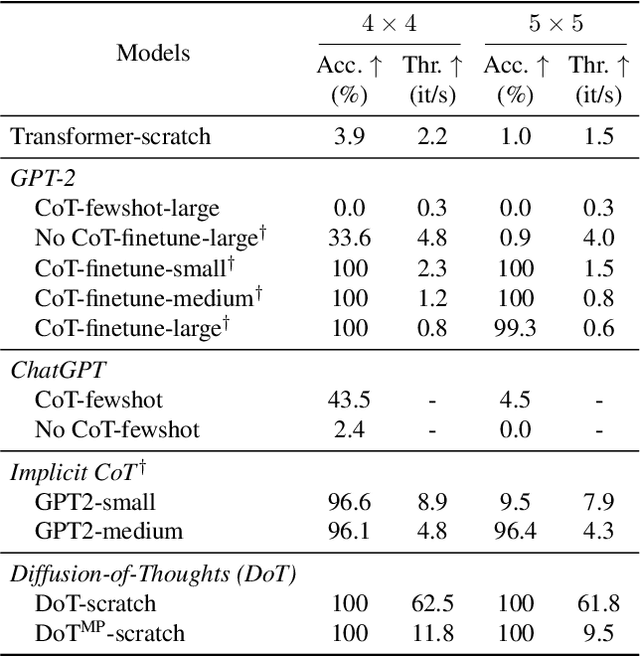

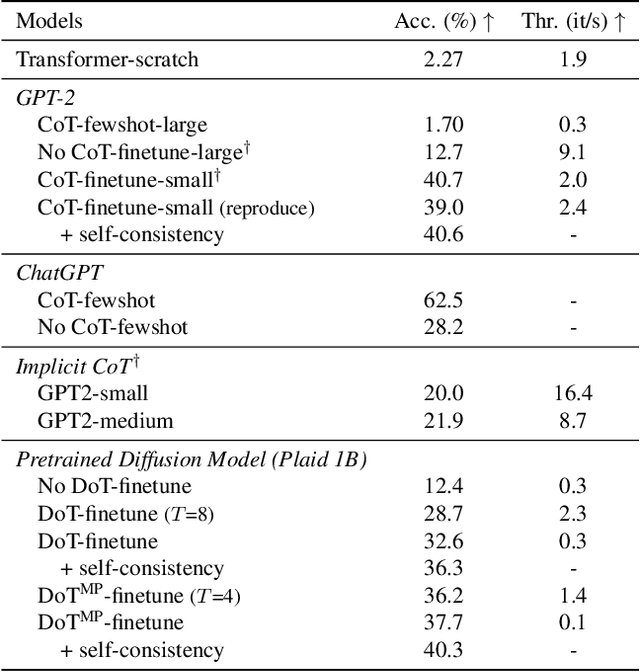
Abstract:Diffusion models have gained attention in text processing, offering many potential advantages over traditional autoregressive models. This work explores the integration of diffusion models and Chain-of-Thought (CoT), a well-established technique to improve the reasoning ability in autoregressive language models. We propose Diffusion-of-Thought (DoT), allowing reasoning steps to diffuse over time through the diffusion process. In contrast to traditional autoregressive language models that make decisions in a left-to-right, token-by-token manner, DoT offers more flexibility in the trade-off between computation and reasoning performance. Our experimental results demonstrate the effectiveness of DoT in multi-digit multiplication and grade school math problems. Additionally, DoT showcases promising self-correction abilities and benefits from existing reasoning-enhancing techniques like self-consistency decoding. Our findings contribute to the understanding and development of reasoning capabilities in diffusion language models.
G-LLaVA: Solving Geometric Problem with Multi-Modal Large Language Model
Dec 18, 2023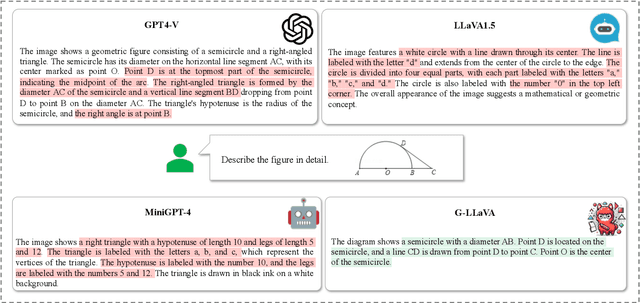
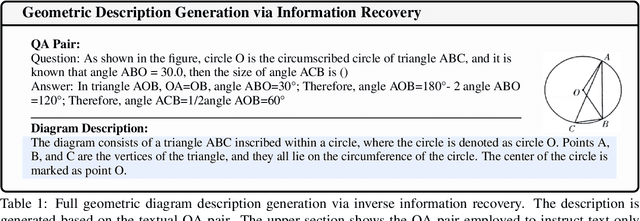
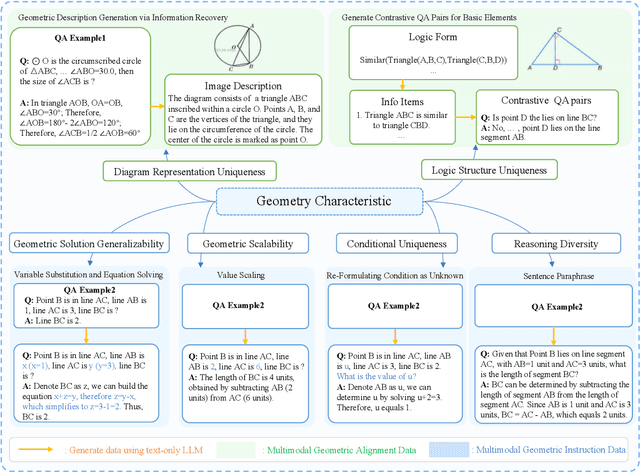
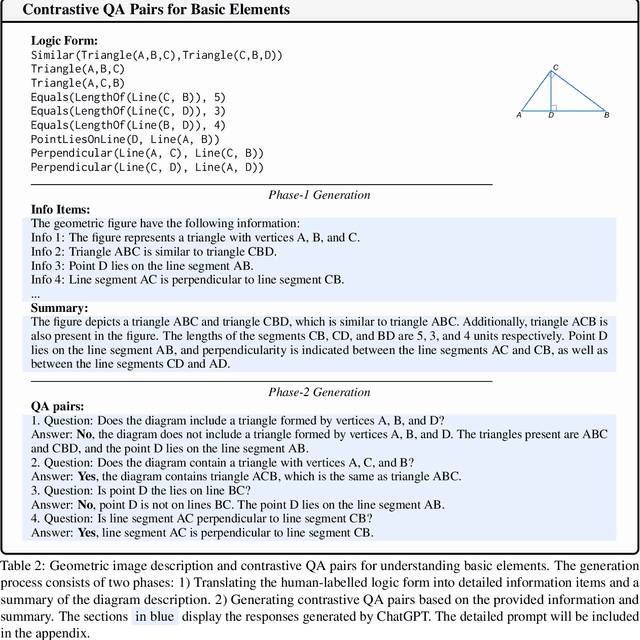
Abstract:Large language models (LLMs) have shown remarkable proficiency in human-level reasoning and generation capabilities, which encourages extensive research on their application in mathematical problem solving. However, current work has been largely focused on text-based mathematical problems, with limited investigation in problems involving geometric information. Addressing this gap, we aim to enable LLMs to solve geometric problems by understanding image input. We first analyze the limitations of current Multimodal Large Language Models (MLLMs) in this area: they struggle to accurately comprehending basic geometric elements and their relationships. To overcome these challenges, we take advantage of the unique characteristics of geometric problems (such as unique geometric logical form, and geometric scalability) and the capacity of the textual LLMs to build an enriched multimodal geometry dataset based on existing data. The augmented dataset, Geo170K, contains more than 170K geometric image-caption and question-answer pairs. Utilizing our constructed Geo170K dataset, we develop G-LLaVA, which demonstrates exceptional performance in solving geometric problems, significantly outperforming GPT-4-V on the MathVista benchmark with only 7B parameters.
Language Versatilists vs. Specialists: An Empirical Revisiting on Multilingual Transfer Ability
Jun 11, 2023



Abstract:Multilingual transfer ability, which reflects how well the models fine-tuned on one source language can be applied to other languages, has been well studied in multilingual pre-trained models (e.g., BLOOM). However, such ability has not been investigated for English-centric models (e.g., LLaMA). To fill this gap, we study the following research questions. First, does multilingual transfer ability exist in English-centric models and how does it compare with multilingual pretrained models? Second, does it only appears when English is the source language for the English-centric model? Third, how does it vary in different tasks? We take multilingual reasoning ability as our focus and conduct extensive experiments across four types of reasoning tasks. We find that the multilingual pretrained model does not always outperform an English-centric model. Furthermore, English appears to be a less suitable source language, and the choice of source language becomes less important when the English-centric model scales up. In addition, different types of tasks exhibit different multilingual transfer abilities. These findings demonstrate that English-centric models not only possess multilingual transfer ability but may even surpass the transferability of multilingual pretrained models if well-trained. By showing the strength and weaknesses, the experiments also provide valuable insights into enhancing multilingual reasoning abilities for the English-centric models.
Generating Data for Symbolic Language with Large Language Models
May 23, 2023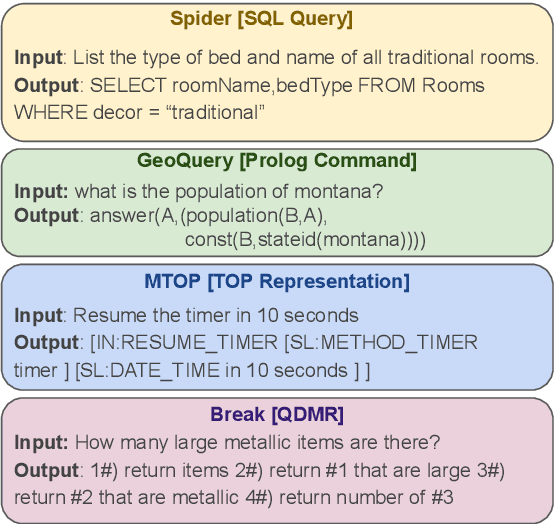
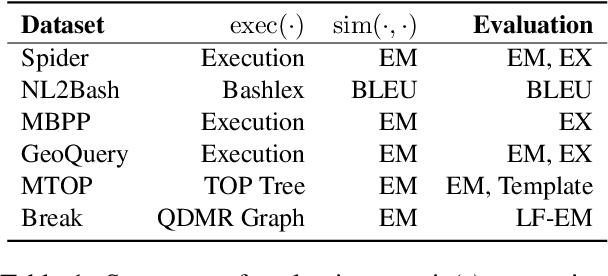
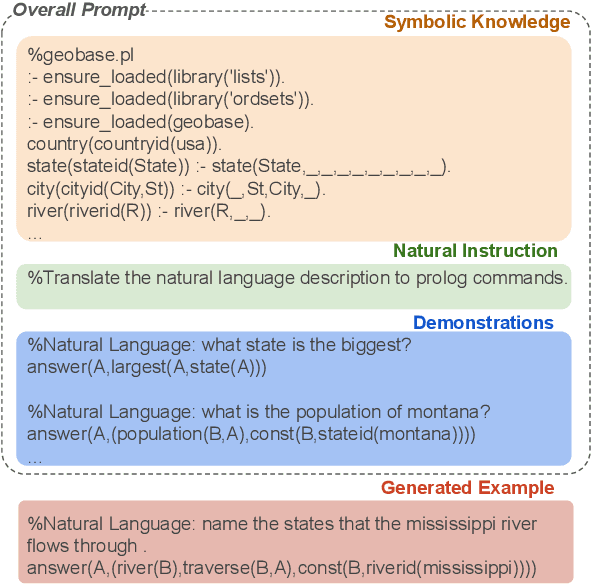
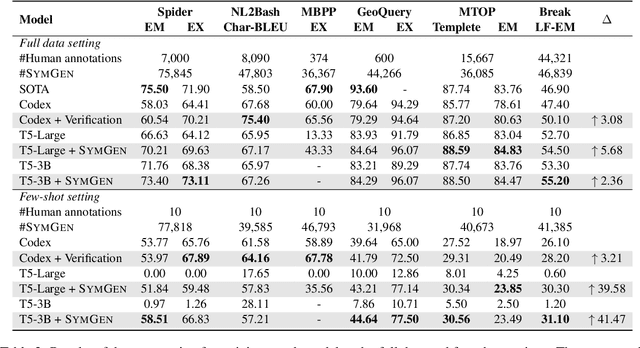
Abstract:While large language models (LLMs) bring not only performance but also complexity, recent work has started to turn LLMs into data generators rather than task inferencers, where another affordable task model is trained for efficient deployment and inference. However, such an approach has primarily been applied to natural language tasks and has not yet been explored for symbolic language tasks with complex structured outputs (e.g., semantic parsing and code generation). In this paper, we propose SymGen which utilizes LLMs for generating various annotation-expensive symbolic language data. SymGen consists of an informative prompt to steer generation and an agreement-based verifier to improve data correctness. We conduct extensive experiments on six symbolic language tasks across various settings. Compared with the LLMs, we demonstrate the 1\%-sized task model can achieve comparable or better performance, largely cutting inference and deployment costs. We also show that generated data with only a few human demonstrations can be as effective as over 10 times the amount of human-annotated data when training the task model, saving a considerable amount of annotation effort. SymGen sheds new light on data generation for complex tasks, and we release the code at \href{https://github.com/HKUNLP/SymGen}{https://github.com/HKUNLP/SymGen}.
OpenICL: An Open-Source Framework for In-context Learning
Mar 06, 2023

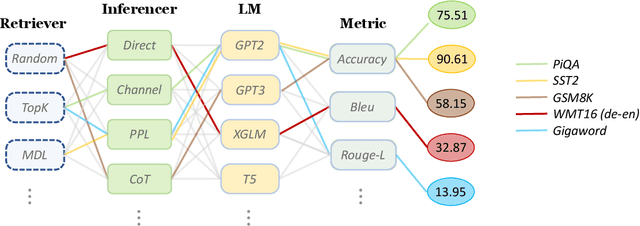
Abstract:In recent years, In-context Learning (ICL) has gained increasing attention and emerged as the new paradigm for large language model (LLM) evaluation. Unlike traditional fine-tuning methods, ICL instead adapts the pre-trained models to unseen tasks without any parameter updates. However, the implementation of ICL is sophisticated due to the diverse retrieval and inference methods involved, as well as the varying pre-processing requirements for different models, datasets, and tasks. A unified and flexible framework for ICL is urgently needed to ease the implementation of the aforementioned components. To facilitate ICL research, we introduce OpenICL, an open-source toolkit for ICL and LLM evaluation. OpenICL is research-friendly with a highly flexible architecture that users can easily combine different components to suit their needs. It also provides various state-of-the-art retrieval and inference methods to streamline the process of adapting ICL to cutting-edge research. The effectiveness of OpenICL has been validated on a wide range of NLP tasks, including classification, QA, machine translation, and semantic parsing. As a side-product, we found OpenICL to be an efficient yet robust tool for LLMs evaluation. OpenICL is released at https://github.com/Shark-NLP/OpenICL
Compositional Exemplars for In-context Learning
Feb 11, 2023Abstract:Large pretrained language models (LMs) have shown impressive In-Context Learning (ICL) ability, where the model learns to do an unseen task via a prompt consisting of input-output examples as the demonstration, without any parameter updates. The performance of ICL is highly dominated by the quality of the selected in-context examples. However, previous selection methods are mostly based on simple heuristics, leading to sub-optimal performance. In this work, we formulate in-context example selection as a subset selection problem. We propose CEIL(Compositional Exemplars for In-context Learning), which is instantiated by Determinantal Point Processes (DPPs) to model the interaction between the given input and in-context examples, and optimized through a carefully-designed contrastive learning objective to obtain preference from LMs. We validate CEIL on 12 classification and generation datasets from 7 distinct NLP tasks, including sentiment analysis, paraphrase detection, natural language inference, commonsense reasoning, open-domain question answering, code generation, and semantic parsing. Extensive experiments demonstrate not only the state-of-the-art performance but also the transferability and compositionality of CEIL, shedding new light on effective and efficient in-context learning. Our code is released at https://github.com/HKUNLP/icl-ceil.
 Add to Chrome
Add to Chrome Add to Firefox
Add to Firefox Add to Edge
Add to Edge